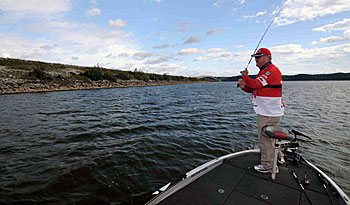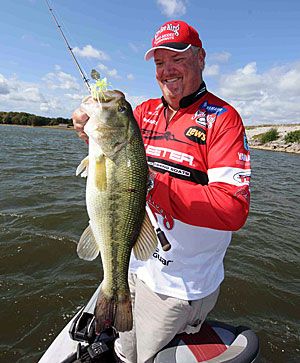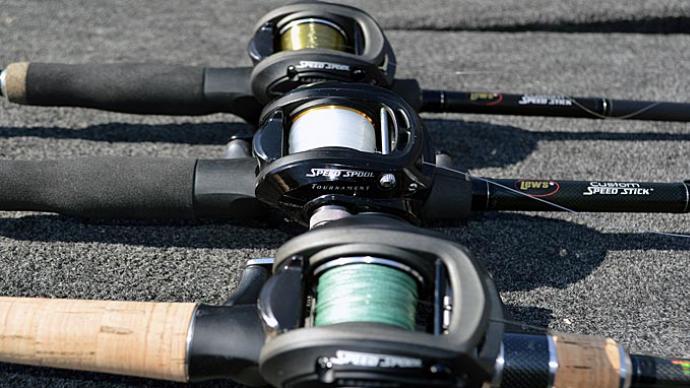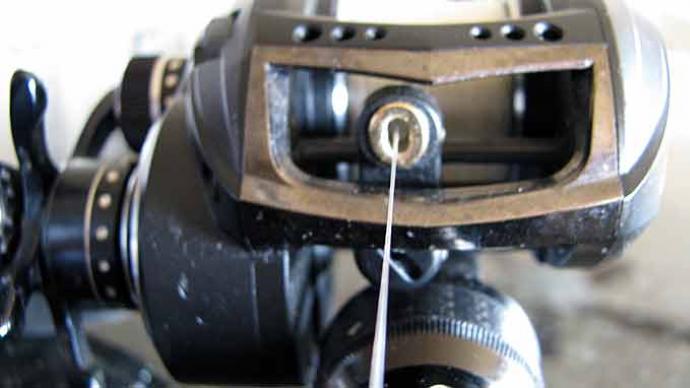
A lure and rod-and-reel combo rank first and second in Bassmaster Elite Series star Mark Davis’ order of importance in fishing, but the link between the two is almost as important.
Fishing line links the lure to the rod and reel and can be the key to success or heartbreaking failure after a bass is hooked. Lines are now available in various sizes and types, making it difficult for novice anglers to decide which lines to buy for bass fishing. Davis relies on a variety of lines for the various tactics he uses on the tournament trail. Here are his choices of line size and type he uses for the following lures and techniques.
- Topwaters: The former Bassmaster Classic champ varies his lines depending on the lure he chooses. For smaller lures such as the Strike King Splash popper, he opts for 14- or 15-pound monofilament. He sometimes uses the same monofilament for a topwater walker, such as the Strike King Sexy Dawg, but he prefers 50-pound Seagaur Smackdown braid in some situations. “If you are in a situation where you have a lot of heavy cover, you need a little extra pull or control on the fish, so certainly braid is a good choice,” Davis says.
- Frogs and toads: 50-pound Seaguar Smackdown braid.
- Pitching jigs and soft plastics: When fishing dirty water, heavy cover, or thick grass, Davis picks 50-pound Smackdown braid. If the water is clear and he is pitching to sparse cover and grass or bushes, Davis selects 20- or 25-pound Seaguar InvizX fluorocarbon.
- Crankbaits: The Arkansas pro claims he uses 10- to 20-pound Seaguar fluorocarbon for his crankbait tactics. “Monofilament still has a small place in cranking, and when I do use monofilament for cranking, I am using spinning tackle,” he says. Davis favors monofilament because it is easier to cast the small crankbaits he uses in the spring. Most of the time, he cranks with 8-pound monofilament but will scale down to 6-pound test in ultra-clear water or upgrade to 10-pound test in murky water.
- Jigging spoons: 20-pound fluorocarbon.
- Suspending stickbaits: 8- to 12-pound fluorocarbon.
- Buzz baits: Davis favors 50-pound braid, but there are times when he likes 20-pound monofilament because he can make long casts, and the line stretches when he sets the hook, which prevents him from pulling the lure away from the fish too quickly.
- Spinnerbaits: 20-pound monofilament and occasionally 20-pound fluorocarbon.
- Soft jerkbaits: A main line of 20-pound braid with a small swivel and a 12- to 15-pound fluorocarbon leader.
- Drop shot rigs: Most of the time, Davis opts for a main line of 10- to 15-pound braid with a 6- to 8-pound fluorocarbon leader. “There are times in extremely clear water when I feel like the fish are line wary, so I will use straight fluorocarbon,” Davis says. “I have seen where that makes a difference in the number of bites I can get, especially fishing clear, deep water.”
- Texas-rigged soft plastics: Fluorocarbon up to 25-pound test when fishing heavy cover.
- Carolina rig: “I like straight fluorocarbon 20-pound test through (the rig),” he says. “I will drop down to as light as 12 on my leader if I feel like I need to, but my go-to is 20-20.”
- Shaky head and wacky worm rig: 8-pound fluorocarbon leader spliced to 15-pound braid main line.
- Floating worm: In super clear water, he uses 12- to 15-pound fluorocarbon, but for most water conditions, Davis sets up his spinning tackle with a main line of 15- to 20-pound braid, a swivel, and a short fluorocarbon leader of 12- to 15-pound test.

Buying so many different types and sizes of lines can get expensive for weekend anglers, so Davis recommends a good multipurpose line. “If I had to fish with just one line, I would take 15-pound test InvizX because, with that line, I can fish with a worm, jig, spinnerbait, and I can crank and throw a Chatterbait,” he says. “It is just a good go-to size and works for many different techniques.”
Another dilemma for recreational or weekend tournament anglers is how often they should change their lines. “If you want optimum performance out of your equipment on spinning tackle, you need to change your line a lot more often than you do on baitcasting,” Davis says. The line twist created by the spinning reel weakens the line, so it must be replaced often.
Some touring pros change their lines after fishing every day, but Davis only does that if he fishes with the same rod and reel all day. He often uses the same spool of braid for six months but changes his line after every two or three trips when fishing crankbaits with fluorocarbon or monofilament.
The five-time B.A.S.S. winner thinks anglers can get in six or a dozen trips with the same line when fishing with baitcasting tackle, depending on how long they use the same rod and reel throughout a day of fishing. He recommends anglers should change their line after at least three trips with spinning gear due to the line twist problem.
Without new line and the correct type of line, that crucial link between the lure and rod and reel can be broken by a vicious strike or hard pull of a heavyweight bass.
BassResource may receive a portion of revenues if you make a purchase using a link above.




